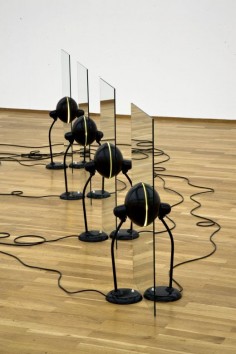ALICJA KWADE

source: kunstmuseumsgch
Kulturhistorische, philosophische sowie naturwissenschaftliche Referenzen finden sich in der künstlerischen Arbeit von Alicja Kwade wieder. Indem sie bestimmte alltägliche Gegenstände wie Uhren, Lampen, Spiegel und andere handelsübliche Objekte spannungsvoll in signifikante Arrangements verwandelt, reflektiert sie komplexe Wechselbeziehungen von Kapital und Produktion sowie abstrakte Werte wie Zeit und Geld. Minimale Zustandsveränderungen durchziehen das gesamte Werk und verweisen auf Themen wie Zeitlichkeit und Stillstand.
Geboren 1979 in Kattowitz, Polen
Lebt und arbeitet in Berlin
Alicja Kwade ist 1979 geboren, lebt und arbeitet in Berlin. Ihr Schaffen wurde in den vergangenen Jahren in zahlreichen Institutionen gezeigt, u.a. 2013 im Haus Esters in Krefeld oder 2012 in der Gruppenausstellung Made in Germany II im Kunstverein Hannover.
.
.
.
.
.
.
.
source: bilderweltenpphotography
Alicja Kwade nació en 1979 en Katowice, Polonia. Desde su infancia, la joven artista ha estado en contacto con el arte. De 1999 a 2005 Kwade estudió Bellas Artes en la Universidad de Bellas Artes en Berlín. Kwade tiene una trayectoria de numerosas exposiciones individuales y colectivas, incluyendo una muestra en Nueva York y en el Hamburger Bahnhof. Además, la artista ha recibido el Premio Piepenbrock (2008) y Robert Jacobsen Premio (2010).
La artista Alicja Kwade trabaja centrándose con las supuestas realidades y preguntas existenciales sobre la verdad y el tiempo. Kwade es uno de los artistas jóvenes más importantes de su generación.
Sus obras se refieren a la relación entre la ficción y las realidades así como los componentes, de los cuales se crea la realidad. Por tanto, tratan sobre la cuestión de la verdad y sobre lo que percibimos como realidad. Para experimentar, la artista utiliza diferentes medios y técnicas. Por ello, trabaja con objetos y materiales reales, inadvertidas, cotidianos o incluso productos de desecho. Procesos geniales como, por ejemplo, la aplicación de oro sobre simples briquetas de carbón, o el reciclaje de botellas de Champán en polvo fino son solo algunos ejemplos de su enorme creatividad. (Obra “Bordsteinjuwelen”) Existe en su trabajo artístico una coherencia conceptual constante.
La realidad no es una construcción estable, sino siempre sólo una instantánea personal.Alicja Kwade
.
.
.
.
.
.
.
source: trendhunter
Alicja Kwade produces art that cannot really be classified into an established genre. Rather, her photos are simple to the point of complexity, inducing curiosity in an audience.
Alicja Kwade draws her inspiration from ideas in books to world news. She has her own breed of curiosity that shows throughout her many galleries, which include videos and sculptures. What sets her apart from the rest is that one may never know where her next masterpiece will be. A running theme in her designs is a mirroring effect where objects that are identical (or nearly identical) sit together in duality. For example, she’ll place two lamps of different shades perfectly opposite one another, making for an impeccably symmetrical piece.
.
.
.
.
.
.
source: nytimes
Alicja Kwade, a cerebrally imaginative artist who lives in Berlin, produces elegantly understated works that are as much thought experiments as sculptures.
All of this invites us to ponder how closely our perceptual and cognitive habits conform to things as they truly are. Does anyone really know what time it is?
.
.
.
.
.
.
.
source: kunstmuseenkrefeldde
With her narrative-figural, at times minimal-purist objects and installations, Alicja Kwade subtly dislocates our perceptions of present-day reality. She takes our norms and the familiar things around us to the point of absurdity by playfully combining everyday objects, or altering, mirroring and multiplying their forms and materials. Weights from old grandfather clocks appear in their dozens and distort the space – and summon up a both symbolic and physical sense of temporality; illuminated globe lamps reflect in a labyrinth of glass panes and suspend the differences between body and anti-body, between reality and illusion. With her works and interventions, Alicja Kwade unhinges our deep-seated mental framework. She infuses our world with a ‘twisted’ objecthood.
Alicja Kwade was born in 1979 in Katowice, Poland, and studied from 1999 to 2005 at the Universität der Künste in Berlin. She currently lives and works in Berlin.
.
.
.
.
.
.
.
source: artsynet
Alicja Kwade’s mixed-media works manipulate mental perceptions and physical experiences of how the body inhabits space and time. Kwade frequently uses imperfect doubling, mirror images, and repetition in her practice. For example, Dimension +1-+9 (2012) and Dimension -1–9 (2012) are a pair of clocks ticking just faster and slower than one second; Nissan (Parallelwelt 1 + 2) (2009) features two Nissan cars as mirror images, including topical scratches. Her common materials include items found in everyday life—like coins, metal pipes, mirrors, glass, lights, and bicycles—that she then distorts to create sensory illusions. The results, sometimes slouching or stretching, can appear anthropomorphic. A recent installation Durchbruch durch Schwäche (Breakthrough Through Weakness) (2011), comprised of over 300 clock weights, was based on the closing sequence of Christopher Nolan’s 2010 film Inception.

